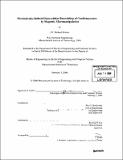| dc.contributor.advisor | Alan J. Grodzinsky. | en_US |
| dc.contributor.author | Motion, J. P. Michael (Joseph Patrick Michael Motion Champana) | en_US |
| dc.contributor.other | Massachusetts Institute of Technology. Dept. of Electrical Engineering and Computer Science. | en_US |
| dc.date.accessioned | 2007-04-20T15:49:08Z | |
| dc.date.available | 2007-04-20T15:49:08Z | |
| dc.date.copyright | 2006 | en_US |
| dc.date.issued | 2006 | en_US |
| dc.identifier.uri | http://hdl.handle.net/1721.1/37202 | |
| dc.description | Thesis (M. Eng.)--Massachusetts Institute of Technology, Dept. of Electrical Engineering and Computer Science, 2006. | en_US |
| dc.description | Includes bibliographical references (leaves 68-72). | en_US |
| dc.description.abstract | Gap junctions are responsible for providing and maintaining a pathway for intercellular communication. This is critical in the heart where gap junctions are responsible for maintaining electrical impulse propagation. Connexin43 (Cx43) is the most abundant gap junction in the heart, and studies have shown that spatial heterogeneity of Cx43 may promote electrical instability and anisotropic conduction pathways that may cause cardiac arrhythmias. Structural and electrical remodeling of gap junctions have been linked to increases in stresses in conditions such as hypertrophy. Understanding how local mechanical forces influence the remodeling of gap junctions can provide insight into arrhythmias and reentry circuits. In this work, I describe a system for exerting local mechanical forces on cardiomyocytes to study gap junction remodeling and I show that cell-to-cell movement and subsequent remodeling of Cx43 can occur. The system consisted of patterned linear strands on polyacrylamide gels and mechanical stimulation using magnetic micromanipulation. Cardiomyocytes were patterned on polyacrylamide gel using 25pm and 50pm microchannels. Mechanical stimulation was induced in sections with high densities of magnetic beads. | en_US |
| dc.description.abstract | (cont.) With a maximal input current of 1.5A, the system generated 1.5nN at 100pm distance from the magnetic trap, and this was sufficient to induce cell-to-cell movement. Cell-to-cell movement was measured to be 0.032±0.03pm/min, three times faster than the average cell-to-cell movement under no applied force. Remodeling of Cx43 was also shown using Cx43-YFP transfected cells while a local force induced cell-to-cell movement. Changes in both the distribution and expression of the protein were seen throughout time as the linear strand was pulled by the magnetic force. We conclude that this system can induce remodeling of Cx43 by an applied local force. This work establishes a system to allow to quantification of applied mechanical loads and resultant Cx43 remodeling. | en_US |
| dc.description.statementofresponsibility | by J.P. Michael Motion. | en_US |
| dc.format.extent | 74 leaves | en_US |
| dc.language.iso | eng | en_US |
| dc.publisher | Massachusetts Institute of Technology | en_US |
| dc.rights | M.I.T. theses are protected by copyright. They may be viewed from this source for any purpose, but reproduction or distribution in any format is prohibited without written permission. See provided URL for inquiries about permission. | en_US |
| dc.rights.uri | http://dspace.mit.edu/handle/1721.1/7582 | |
| dc.subject | Electrical Engineering and Computer Science. | en_US |
| dc.title | Mechanically-induced intercellular remodeling of cardiomyocytes by magnetic micromanipulation | en_US |
| dc.type | Thesis | en_US |
| dc.description.degree | M.Eng. | en_US |
| dc.contributor.department | Massachusetts Institute of Technology. Department of Electrical Engineering and Computer Science | |
| dc.identifier.oclc | 78926755 | en_US |
